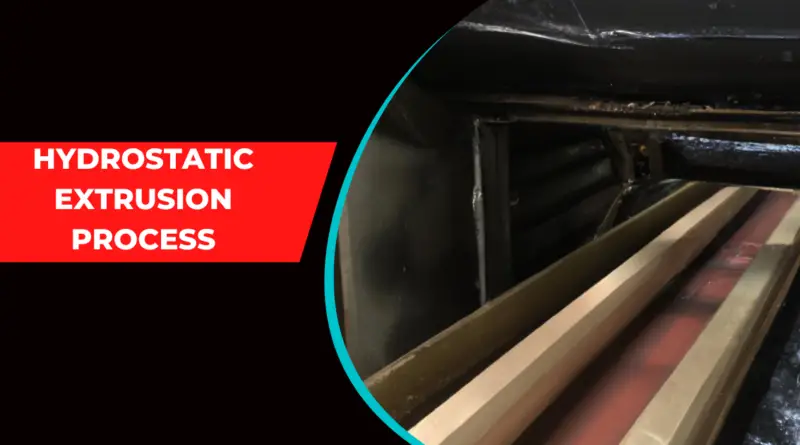A Comprehensive Guide to Hydrostatic Extrusion Process, Technology and Applications
Exploring the Basics of Hydrostatic Extrusion Process
Hydrostatic extrusion is a metal forming process that uses high pressure fluid to shape and form metals into desired shapes. It is used in various industries such as aerospace, automotive, medical, and electronics. The hydrostatic extrusion process can be used to produce complex shapes with a high degree of accuracy. It also offers many advantages over traditional metal forming processes such as greater control over the material’s properties and better surface finish.

The hydrostatic extrusion process is based on the principle of fluid mechanics, where a high-pressure liquid is forced into the die and expelled through a nozzle. As the gas enters the die it forms a cavity that expands dramatically as it reaches its target shape. This happens because in hydrostatic extrusion, pressure builds to produce cavities inside an object that are pulled further apart with each successive layer of extruded material. There are three main types of hydrostatic extrusions: conveying, transporting, and jetting. These processes differ mainly in how they drive pressure into and out of their respective cavities.
Conveying hydrostatic extrusion is used in situations where the piggyback (or “on-demand”) process is not well suited, such as when large volumes of material need to be produced in a continuous fashion. It involves filling a die with a fluid and using pressure to force it upward out of the die, typically through an orifice that forms the end of a nozzle. Conveying also allows for “non-wetting” methods of material transport, which are useful when adjacent surfaces need to remain dry and no contact is desired between them and anything else in the system.
Transporting hydrostatic extrusion is used to transport material from point A to point B. It’s typically used in the injection molding of plastics and rubber. The process starts with a bed of granulated material, which is forced through an orifice at the end of a nozzle into a plastic melt pool that has been heated by an appropriately designed heat source. The molten plastic is then forced out through another nozzle, also at the end of a nozzle, and deposited onto the substrate that is to be formed.
Jetting hydrostatic extrusion is similar to transporting hydrostatic extrusion but instead of being forced through a nozzle, the molten plastic is ejected from the nozzle and deposited on a substrate using jets of hot fluid instead of a nozzle.
Overview of Hydrostatic Extrusion Technology and its Benefits
Hydrostatic extrusion is a metal forming technique that uses high-pressure liquid to form metal parts. It is a cost-effective and efficient way to extrude metal, and it offers several advantages over traditional methods of metal forming.
Hydrostatic extrusion provides greater control over the shape of the final product, as well as increased strength and accuracy. It also allows for more complex shapes to be formed with fewer steps than traditional techniques. Additionally, hydrostatic extrusion can be used with a variety of metals, including aluminum, stainless steel, titanium, and copper alloys.
The benefits of hydrostatic extrusion make it an attractive option for many industrial applications. From automotive components to aerospace parts, hydrostatic extrusion provides an effective way to form complex shapes quickly and accurately.
What are the Key Applications & Industries Where Hydrostatic Extruded Products are Used?
Hydrostatic extrusion is a process used for manufacturing components with complex shapes and geometries. It is used in various industries such as medical device manufacturing, automotive, aerospace and defense, and consumer products for creating high-precision parts. The process involves using pressurized fluid to shape metal or plastic into desired shapes. It is a cost-effective method of producing complex parts with excellent dimensional accuracy and surface finish.
The key applications of hydroforming include medical device manufacturing, automotive components such as fuel tanks, wheels and frames, aerospace components such as landing gear components and airframes, consumer products such as furniture legs and handles, electrical appliances such as washing machines and refrigerators. The hydroforming process can also be used in the production of bicycle frames. This process offers advantages like improved strength-to-weight ratio due to the uniform wall thickness of the part produced and improved surface finish due to the absence of welds or joints.
What is the Future Outlook for Hydrostatic Extrusion Processes?
Hydrostatic extrusion processes are becoming increasingly popular in the metal forming industry due to their ability to form complex shapes with high accuracy and repeatability. As technology advances, hydrostatic extrusion processes are expected to become even more efficient and cost-effective for a variety of applications.
In the future, hydrostatic extrusion processes will continue to be used for a wide range of metal forming tasks. This includes producing components with complex geometries, developing new materials with improved properties, and increasing production efficiency. Additionally, advancements in automation and robotics will allow hydrostatic extrusion processes to be used in a more automated manner. This could lead to greater efficiency gains and cost savings for manufacturers.
How does the hydrostatic extrusion process work?
Hydrostatic extrusion is a metal forming process that uses a die and an external pressure source to deform the material into the desired shape. This process is used for both hot and cold working of metals, allowing for complex shapes to be formed with minimal effort. The hydrostatic extrusion process involves the application of an external pressure source, such as a hydraulic cylinder, to push the material through a die in order to create the desired shape. By controlling the pressure applied, it’s possible to achieve precise dimensional accuracy while also reducing scrap rates. Additionally, this process can be used with materials that are difficult to form using other methods such as aluminum alloys and titanium alloys.
What are the advantages of using the hydrostatic extrusion process?
- Hydrostatic extrusion is an efficient process used to form metal and plastic components into complex shapes.
- It is a cost-effective and highly accurate method of forming parts with precise dimensions, making it a popular choice for many businesses.
- With hydrostatic extrusion, businesses can benefit from improved production times and reduced material waste, while also achieving higher quality parts with greater strength and durability.
- Additionally, hydrostatic extrusion can produce parts with better mechanical properties due to the uniformity of the material during the forming process.
- This process offers several advantages over traditional methods such as die casting or machining, including
- increased accuracy,
- shorter lead times,
- improved surface finish quality,
- lower tooling costs, and fewer defects.
What types of materials can be processed with this process?
The materials that can be processed with hydrostatic extrusion include aluminum, copper, steel, and other metals as well as plastics and composites. This process can also be used to form wire, rods, tubes, and profiles of any shape or size. The advantages of this process include improved surface finish, greater accuracy in dimensional tolerances, and faster production times compared to traditional methods.
What are the common applications of hydrostatic extrusion?
Hydrostatic extrusion is an important process in the manufacturing industry. It is used to form complex shapes from solid materials such as metals, plastics, and composites. This process involves the application of a high-pressure liquid or gas to a material in order to shape it into a desired form. Hydrostatic extrusion has many applications across various industries including automotive, aerospace, medical, and more. Common applications of hydrostatic extrusion include forming intricate components for aircraft engines and fuel systems, producing medical implants and prosthetics, creating complex shapes for automotive parts such as pistons and valves, and forming components for consumer electronics.
Are there any limitations to the hydrostatic extrusion process?
Hydrostatic extrusion is a process that is used to form metal components into specific shapes. It is a cost-effective and efficient method for producing complex parts with tight tolerances. However, as with any manufacturing process, there are certain limitations to the hydrostatic extrusion process. These limitations include the need for expensive tooling, difficulty in achieving intricate geometries, and limited material selection. In addition, it can be difficult to produce components with high accuracy due to the nature of the process. Despite these limitations, hydrostatic extrusion provides an excellent solution for many applications that require precision parts with complex geometries.
Does this process require high pressure or temperature for operation?
It uses a combination of pressure and temperature to form the material, making it an ideal choice for forming complex shapes. The process requires high pressure and temperature, depending on the type of material being formed. The pressure and temperature required will vary depending on the type of material being extruded, as well as its size and shape.



